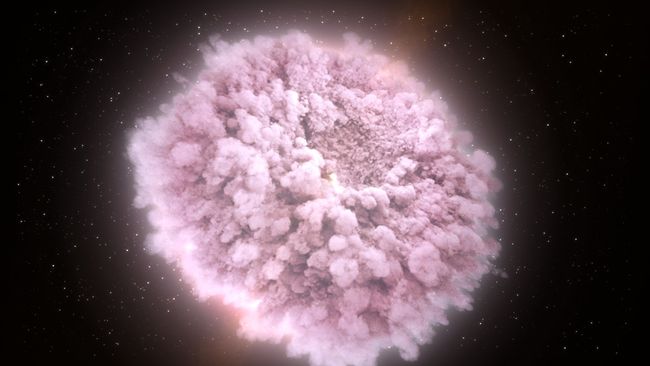A Nearby Neutron Star Collision Could Cause Calamity on Earth
By John Wenz | Popular Mechanics Writer and Space ObsessiveSPACE.COM – October 30, 2017 | A long time ago in a galaxy far away—NGC 4993, to be exact—two neutron stars collided and created a spectacular light show.
After billions of years spent slowly circling each other, in their last moments the two degenerate stars spiraled around each other thousands of times before finally smashing together at a significant fraction of light-speed, likely creating a black hole. The merger was so violent it shook the universe, emitting some 200 million suns’ worth of energy as perturbations in the fabric of spacetime called gravitational waves. Those waves propagated out from the merger like ripples on a pond, eventually washing over Earth—and into our planet’s premiere gravitational-wave detectors, the U.S.-built LIGO and European-built Virgo observatories.
This illustration the hot, dense, expanding cloud of debris stripped from neutron stars just before they collide in a “kilonova,” or an explosion 1,000 times stronger than a typical nova.
(Image: © NASA’s Goddard Space Flight Center/CI Lab)Yet gravitational waves were not the merger’s only products. The event also emitted electromagnetic radiation—that is, light—marking the first time astronomers have managed to capture both gravitational waves and light from a single source. The first light from the merger was a brief, brilliant burst of gamma rays, a probable birth cry of the black hole picked up by NASA’s Fermi Gamma-Ray Space Telescope. Hours later astronomers using ground-based telescopes detected more light from the merger—a so-called “kilonova”—produced as debris from the merger expanded and cooled. For weeks much of the world’s astronomical community watched the kilonova as it slowly faded from view.
As astronomers studied the merger’s aftermath in various wavelengths of light, they saw signs of countless heavy elements forming instantly. Astronomers had long predicted merging neutron stars may be responsible for forming elements such as gold and titanium, neutron-rich metals that are not known to form in stars. Most everything they saw in the changing light of the merger’s kilonova matched those predictions, although no one definitively, directly saw the merger spewing out gold nuggets by any stretch.
Even seen across its estimated 130 million light-year separation from us, the event was big, bright and glorious. Based on the rarity of neutron stars—let alone ones that happen to merge—it is unlikely we will ever see such a display significantly closer to us. But let’s imagine if we could—if it happened in the Milky Way or one of its several satellite galaxies. Or, heaven forbid, in our immediate stellar neighborhood. What would we see? What effects would it have on our home world? Would the environment, civilization, even humanity, emerge intact?
Instant Action
The Big Boom
Death from Above
Improbabilities
